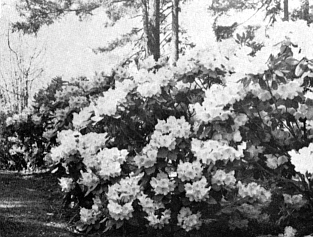QBARS - v15n1 The Ten Best Hybrid Rhododendrons I Have Grown
The Ten Best Hybrid Rhododendrons I Have Grown
John Henny
Considerable discussion and a number of letters and articles have appeared in the Society Bulletin in regard to a list of rhododendrons that I presented to the Oakland Chapter of the Society as being in my estimation the ten best rhododendron hybrids. Since this list has not at this date been printed I have been requested to publish the list as I presented it. Everyone has their own opinion on such a list much as the controversies that often rage over art and artists, and likes and dislikes are often varied and widely separated.
I have for years had a list of what I considered the ten best or ten first class rhododendron hybrids. The word first class is used and I somehow like the way the late Mr. J. B. Stevenson of Tower Court used it. Rhododendrons were either first class, first class second class or absolutely second class. A list of this type is necessarily difficult to do as there are so many factors such as temperature, soil conditions, sun, wind and summer heat to be considered. Therefore this list is made up with the conditions as they exist on the Pacific Coast and particularly the Northwest. Consideration is given to quality of the flower as well as to the foliage and plant habit. The selections are made after at least fifteen years experience with them in propagating, handling, growing and flowering. The order in which they are listed has nothing to do with their desirability as they are all first class in my opinion. Some of them, where plant type and usefulness in the garden are quite similar, will be listed as one variety.
1. 'CARITA' A. M. This rhododendron should be grown with some protection from the full sun for best results as the foliage will tend to burn. The flower is yellow. The foliage is good and plant habit neat and compact.

|
|---|
Fig. 2. 'Carita' in the Society Garden at Crystal Springs R. Henny photo |
2. 'LODERI' In almost any clonal form, as they are all very large flowered, fleshy and scented. The plant habit and foliage are to all practical intents and purposes the same. The color will vary from blush pink to ivory white. Must be kept out of strong winds.
3. 'BLUE BIRD', 'BLUE DIAMOND', 'BLUE TIT', 'SAPPHIRE' These will all serve the same purpose in the landscape plan with some differences in shade of blue. 'Sapphire' is the smallest growing. 'Blue Bird' and 'Blue Tit' have much the same habit with the latter the lighter blue. 'Blue Diamond' is more upright. All will do better in a somewhat sunny location and too much shade will tend to make them open and leggy.
4. 'MOONSTONE' A slow growing very compact habit plant and one of very few R. campylocarpum hybrids that will tolerate considerable sun. Will completely cover itself with creamy yellow bells.

|
|---|
Fig. 3. R. 'Moonstone' C. Smith photo |
5. 'BOW BELLS' Also a compact slow growing variety that will withstand a less sunny location and covers itself with soft pink flowers.
6. 'ELIZABETH' Also a compact slow growing plant that is very floriferous and not too fastidious as to location. The flowers are a light blood red.
7. 'MRS. FURNIVAL' Pink with a blotch in the upper petal. The foliage is a good dark green. The plant is a sturdy grower and quite hardy. Will grow in considerable sun but flowers will last longer if some shade is provided as it flowers in late May.

|
|---|
Fig. 4. R. 'Mrs. Furnival' Generally agreed to be the best of the blotched types. C. Smith photo |
8. 'NAOMI' There are quite a number of forms and my choices would be 'Exbury,' pink edges creamy center, 'Glow,' a deep pink and 'Pixie,' a deep pink with a red blotch in the throat. Most all of them however are good.

|
|---|
Fig. 5. R. 'Naomi Exbury' R. Henny photo |

|
Fig. 6. R. 'Naomi Carissima' in the Society Garden, Crystal Springs R. Henny photo |
9. 'LODER'S WHITE' The flowers are large and frilled with good lasting qualities. The habit of growth is sturdy and fairly compact if grown with considerable light. This is most certainly the one I would not want to be without if I lived in an area where it could be grown.
10. 'FAGGETTER'S FAVORITE' This rhododendron grows into a quite large plant. The foliage is good and the flowers are borne in a tall compact truss of the most beautiful shade of soft pink.

|
|---|
Fig. 1. R. 'Faggetter's Favorite'. A large growing rhododendron well suited to be grown as a companion plant with Loderi varieties. C. Smith photo |
There undoubtedly will be many who will not agree with the above list and that no doubt is as it should be. Nevertheless, it is an honest compilation with no prejudices.
There are also quite a number of near misses of first class such as R. 'David', R. 'Earl of Athlone', R. 'Britannia', R. 'Marinus Koster', R. 'Mrs. G. W. Leak'. Perhaps in some later article we could make a list of these. There are also a number of more recent ones that certainly show promise of being first class, but they have not been observed long enough. Two of these that immediately come to mind are R. 'Leo' ('Britannia' x elliottii ) and most certainly R. 'Olympic Lady' ( williamsianum x 'Loderi').

